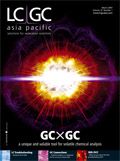Analysis of Secondary Metabolites from Myxobacteria using ESI-TOF–MS and PCA
LCGC Asia Pacific
Daniel Krug, Gabriela Zurek, Birgit Schneider, Carsten Bässmann and Rolf Müller, Bruker Daltonik
Bacterial species producing secondary metabolites increasingly gain attention as a rich source of natural products with interesting structures and biological activities.1 A prominent example for compounds discovered from Myxobacteria are the Epothilones produced by Sorangium cellulosum, which are promising anti-cancer agents currently in clinical trials. Chromatographic separation of bacterial culture extracts combined with electrospray time-of-flight mass spectrometry (ESI-TOF–MS) analysis is a powerful tool for the comparison of production patterns from different strains and the identification of putative novel compounds via their molecular formula. Manual data examination, however, is a time-consuming bottleneck in screening experiments. Statistical methods help to facilitate the extraction of relevant information from these complex samples. It is necessary to discriminate signals representing a meaningful deviation between different strains from the underlying background noise and biological variation because of the fermentation process. Myxococcus xanthus is a Gram-negative soil bacterium with an interesting complex life cycle including the formation of fruiting bodies upon starvation (as depicted in Figure 1). It is also a well-known producer of secondary metabolites, examples are the Myxochromides2 and the antibiotic Myxovirescin.3
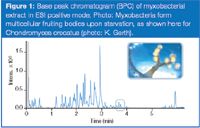
Figure 1
We describe a metabolomics based approach for the screening of extracts from myxobacteria using ESI-TOF–MS data, principle component analysis (PCA) and a subsequent identification via the molecular formula from the accurate mass spectrum.4 A set of three different strains with six biological replicates each was analysed.
Experimental
Fermentation and extraction of bacteria: Fermentation of Myxococcus was performed in a 50 mL scale using complex media. Cultures contained XAD-16 resin to absorb metabolites. Cells and absorber resin were harvested by centrifugation and extracted with methanol. Three different Myxococcus strains were fermented with six biological replicates of each strain. Samples were diluted in acetonitrile/water prior to injection.
LC–MS conditions: LC–MS measurements were performed using a micrOTOF ESI-TOF mass spectrometer (Bruker Daltonik GmbH, Bremen, Germany) coupled to a UPLC system equipped with photodiode array detector (Waters, Milford, Massachusetts, USA) controlled by HyStar within the Compass suite (Bruker Daltonik GmbH). Data was acquired in electrospray (ESI) positive in a scan range from 150–1000 m/z at a sampling rate of 2 Hz.
Data evaluation: Data evaluation was performed with ProfileAnalysis for PCA and Generate Molecular Formula (GMF) in DataAnalysis (Bruker Daltonik GmbH). The LC–MS data was prepared for PCA analysis in ProfileAnalysis using a bucketing approach of the raw data. The LC–MS data was integrated from 0.2–7.5 min and 200–900 m/z in time- and m/z-buckets of 0.2 min and 1 m/z. Each data set was normalized to the total intensity in an analysis.
Results
This study of myxobacterial extracts from three different strains had two objectives. The biological variation of a replicate fermentation process of one strain was assessed and the identification of putative markers of a particular strain was performed.
A typical chromatogram of an extract from strain B acquired in ESI positive mode is depicted in Figure 1. The dashed lines indicate the time segment containing the external calibrant sodium formate. The chromatographic separation can be significantly accelerated using novel fast chromatography systems like an UPLC. Regular run times of approximately 1 hour (using a conventional RP18 125 × 2 mm, 3 μm particle size column) can be reduced to 7 min without compromising the separation efficiency
The LC–MS data were analysed using PCA to visualize the variance in the data set.4 PCA of extracts from three strains producing the same predominant compounds revealed considerable deviation within replicate fermentations, but still resulted in formation of groups indicative of subtle systematic differences between their metabolite profiles. The grouping of the three strains is shown in the scores plot (Figure 2). The explained variance in principle component PC 1 vs PC 2 comprises 65% indicating the need to also analyse higher PCs to explain all variance in the data.
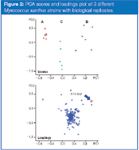
Figure 2
Strain B exhibits an increased production of a compound with 519 m/z at a retention time of 3.7 min compared to the other strains. This information can be retrieved from the loadings plot (retention times not shown in loadings plot).
To compare the different production patterns in more detail, the extracted ion chromatogram (EIC) traces of 519 m/z were created for all samples as shown in Figure 3. In the time range from 3.62 to 3.80 min two isomers with identical mass spectra are detected. The intensity in strain B is the largest compared to strain A and C. The compound of interest is present as minor component in the total extract as can be seen in Figure 1. The small rectangle marks the considered retention time range. This fact demonstrates the strength of the PCA analysis to facilitate the retrieval of relevant information from a number of very complex chromatograms well.
The averaged mass spectrum of the peak 519 m/z was calculated (see Figure 3) and was subjected to GMF to identify the elemental composition. GMF evaluates the formula suggestion using both accurate mass and isotopic pattern information using the Sigma-Fit algorithm.5 The smaller the sigma value the better the fit of the measured to the simulated pattern.
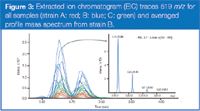
Figure 3
The GMF result of target ion 519 m/z is shown in Figure 4. The first hit is formula C29H35N4O5 for the accurate mass value [M+H]+ 519.2608 m/z with a measured mass deviation of –1.1 ppm and a sigma value of 0.0062. The formula indicates that this compound belongs to the compound class of DKxanthenes with the structure of DKx-518 depicted in Figure 4. DKxanthenes are important for the lifecycle of Myxococcus xanthus and were found to be responsible for the yellow colouring of these strains.6
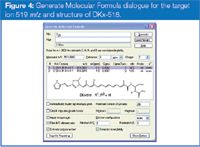
Figure 4
Conclusion
We demonstrate that differences in secondary metabolite production patterns of myxobacterial strains can be extracted by PCA, even considering significant biological variation within replicate fermentations. It was shown that accurate mass data from ESI-TOF–MS is an important key to enable the identification of compounds according to their molecular formula. We project an application to the discovery of novel compounds produced by myxobacteria, by enabling at the same time rapid de-replication and definition of putative target compounds for further studies. This is of special importance for research concerning natural products from myxobacterial strains, which are often talented multiproducers of secondary metabolites.
Acknowledgements
Myxococcus strains are from the collection of G.J. Velicer (MPI, Tübingen, Germany). R. Müller gratefully acknowledges funding from "Deutsche Forschungsgemeinschaft" (DFG) and "Bundesministerium für Bildung und Forschung" (BMBF).
Daniel Krug,1 Gabriela Zurek,2 Birgit Schneider,2 Carsten Bässmann2 and Rolf Müller,1
1Universität des Saarlandes, Pharmaceutical Biotechnology, Saarbrücken, Germany 2Bruker Daltonik GmbH, Bremen, Germany.
References
1. K. Gerth et al., J. Biotechnol., 106(2–3), 233–253 (2003).
2. S. Wenzel et al., Angew Chem Int Ed, 45(14), 2296–2301(2006).
3. V. Simunovic et al., ChemBioChem, 7, 1206–1220 (2006).
4. G. Zurek et al., LCGC Eur. App. Book, (March 2006).
5. S. Ojanperä et al., Rapid Commun. Mass Spectrom, 20, 1161–1167 (2006).
6. P. Meiser et al., PNAS, 105(50), 19128–19133 (2006).

Bruker Daltonik
Fahrenheitstrasse 4, D-28359 Bremen, Germany
tel. +49 421 2205 0 fax +49 421 2205 104
E-mail: sales@bdal.de Website: www.bdal.com
